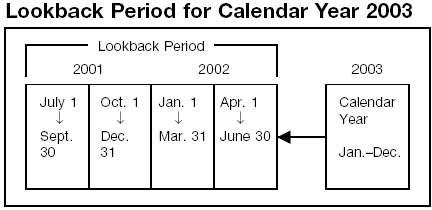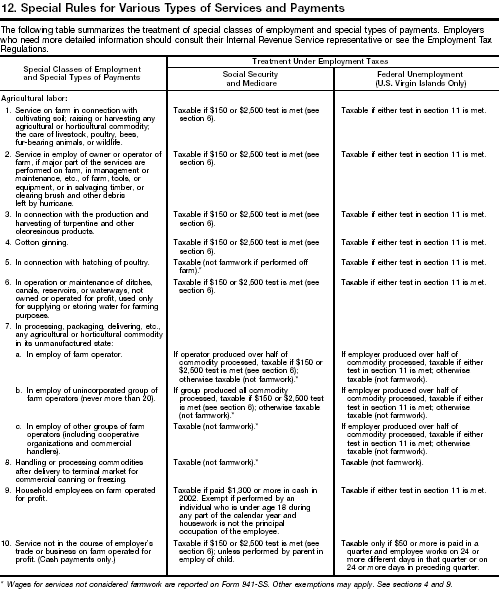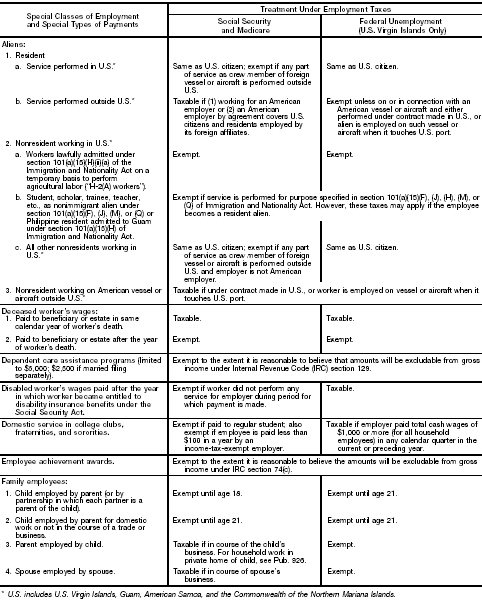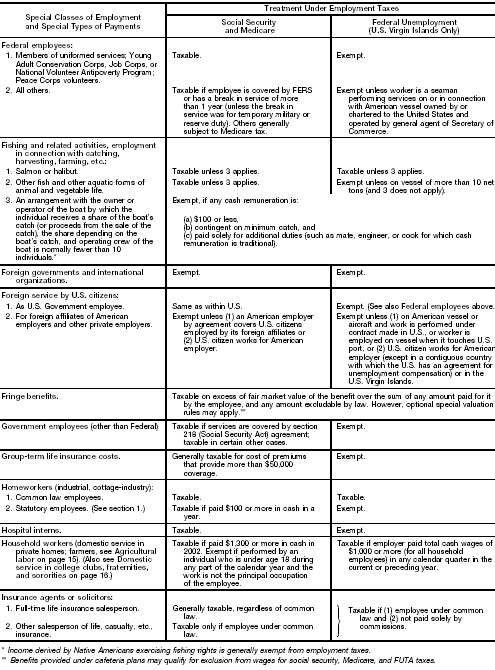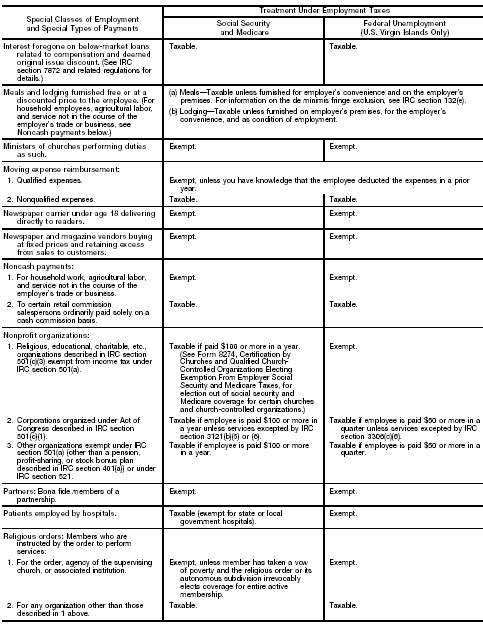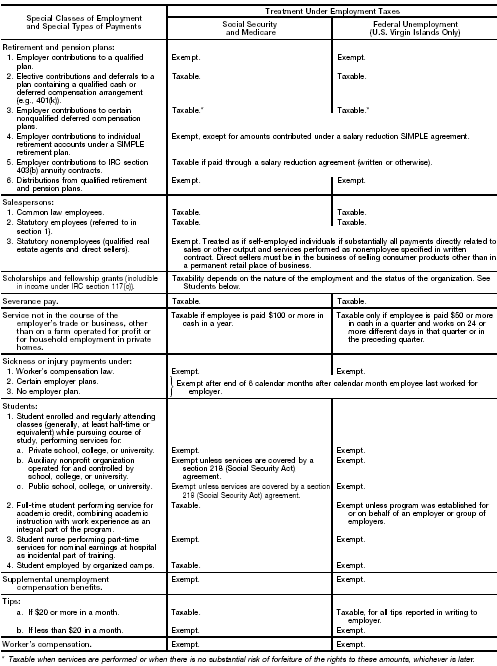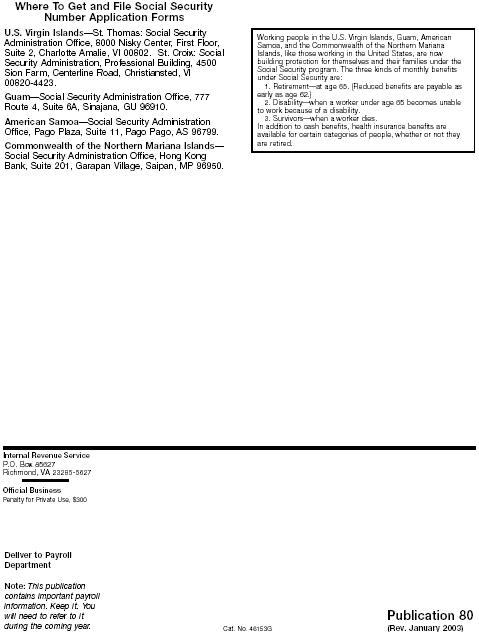 |
2002 Tax Help Archives |
Rose Co. is a monthly schedule depositor for 2000 because its taxes for the 4 quarters in its lookback period ($48,000 for the 3rd quarter of 1998 through the 2nd quarter of 1999) were not more than $50,000. However, for 2001, Rose Co. is a semiweekly schedule depositor because the total taxes for the 4 quarters in its lookback period ($51,000 for the 3rd quarter of 1999 through the 2nd quarter of 2000) exceeded $50,000. Employers of farmworkers. Red Co. reported taxes on its 1998 Form 943 of $48,000. On its 1999 Form 943, it reported taxes of $60,000. Red Co. is a monthly schedule depositor for 2000 because its taxes for its lookback period ($48,000 for calendar year 1998) were not more than $50,000. However, for 2001, Red Co. is a semiweekly schedule depositor because the total taxes for its lookback period ($60,000 for calendar year 1999) exceeded $50,000. Deposits on Banking Days Only If a deposit due date falls on a day that is not a banking day, the deposit is considered timely if it is made by the close of the next banking day. In addition to Federal and state bank holidays, Saturdays and Sundays are treated as nonbanking days. For example, if a deposit is required to be made on Friday, but Friday is not a banking day, the deposit is considered timely if it is made by the following Monday (if Monday is a banking day). Semiweekly schedule depositors will always have at least 3 banking days to make a deposit. That is, if any of the 3 weekdays after the end of a semiweekly period is a banking holiday, you will have one additional banking day to deposit. For example, if a semiweekly schedule depositor accumulated taxes for payments made on Friday and the following Monday is not a banking day, the deposit normally due on Wednesday may be made on Thursday (allowing 3 banking days to make the deposit). Application of Monthly and Semiweekly Schedules
The examples below illustrate the procedure for determining the deposit date under the two different deposit schedules. Monthly schedule example. Green Inc. is a seasonal employer and a monthly schedule depositor. It pays wages each Friday. During January 2001, it paid wages but did not pay any wages during February. Green Inc. must deposit the combined tax liabilities for the January paydays by February 15. Green Inc. does not have a deposit requirement for February (due by March 15) because no wages were paid in February and, therefore, it did not have a tax liability for February. Semiweekly schedule example. Blue Co., a semiweekly schedule depositor, pays wages on the last day of the month. Blue Co. will deposit only once a month because it pays wages only once a month, but the deposit will be made under the semiweekly deposit schedule as follows. Blue Co.'s tax liability for the April 30, 2001 (Monday) payday must be deposited by May 4, 2001 (Friday). Payment With Return For tax return periods beginning in 2001, you may make a payment with Forms 941-SS or 943 instead of depositing if:
$100,000 Next-Day Deposit Rule If you accumulate taxes of $100,000 or more on any day during a deposit period, you must deposit by the close of the next banking day, whether you are a monthly or a semiweekly schedule depositor. For monthly schedule depositors, the deposit period is a calendar month. For semiweekly schedule depositors, the deposit periods are Wednesday through Friday and Saturday through Tuesday. For purposes of the $100,000 rule, do not continue accumulating taxes after the end of a deposit period. For example, if a semiweekly schedule depositor has accumulated taxes of $95,000 on Tuesday and $10,000 on Wednesday, the $100,000 next-day deposit rule does not apply because the $10,000 is accumulated in the next deposit period. Thus, $95,000 must be deposited by Friday and $10,000 must be deposited by the following Wednesday. In addition, once you accumulate at least $100,000 in a deposit period, stop accumulating at the end of that day and begin to accumulate anew on the next day. For example, Fir Co. is a semiweekly schedule depositor. On Monday, Fir Co. accumulates taxes of $110,000 and must deposit on Tuesday, the next banking day. On Tuesday, Fir Co. accumulates additional taxes of $30,000. Because the $30,000 is not added to the previous $110,000 and is less than $100,000, Fir Co. must deposit the $30,000 by Friday using the normal semiweekly deposit schedule. If you are a monthly schedule depositor and you accumulate a $100,000 tax liability on any day during a month, you become a semiweekly schedule depositor on the next day and remain so for the remainder of the calendar year and for the following calendar year. Example of $100,000 next-day deposit rule. Elm Inc. started business on May 4, 2001. Because Elm Inc. is a new employer, the taxes for its lookback period are considered to be zero; therefore, Elm Inc. is a monthly schedule depositor. On May 11, Elm Inc. paid wages for the first time and accumulated taxes of $40,000. On May 18 (Friday), Elm Inc. paid wages and accumulated taxes of $60,000, for a total of $100,000. Because Elm Inc. accumulated $100,000 on May 18, it must deposit $100,000 by May 21 (Monday), the next banking day. Elm Inc. immediately becomes a semiweekly schedule depositor for the remainder of 2001 and for 2002 but may be subject to the $100,000 next-day deposit rule if it accumulates $100,000 again in any semiweekly deposit period. Accuracy of Deposits Rule You are required to deposit 100% of your tax liability on or before the deposit due date. However, penalties will not be applied for depositing less than 100% if both of the following conditions are met:
Employers of Both Farm and Nonfarm Workers If you employ both farm and nonfarm workers, you must treat employment taxes for the farmworkers (Form 943 taxes) separately from employment taxes for the nonfarm workers (Form 941-SS taxes). Form 943 taxes and Form 941-SS taxes are not combined for purposes of applying any of the deposit rules. If a deposit is due, deposit the Form 941-SS taxes and Form 943 taxes separately, as discussed next. How To Deposit The two methods of depositing employment taxes are discussed next. See Payment With Return on page 9 for exceptions explaining when taxes may be paid with the tax return instead of deposited. Electronic deposit requirement. You must make electronic deposits of all depository taxes (such as employment tax, excise tax, and corporate income tax) using the Electronic Federal Tax Payment System (EFTPS) in 2001 if:
If you are required to EFTPS and fail to do so, you may be subject to a 10% penalty. If you are not required to use EFTPS, you may participate voluntarily. To get more information or to enroll in EFTPS, call 1-800-555-4477 or 1-800-945-8400. Depositing on time. For deposits made by EFTPS to be on time, you must initiate the transaction at least one business day before the date the deposit is due. Making deposits with FTD coupons. If you are not making deposits by EFTPS, use Form 8109, Federal Tax Deposit Coupon, to make the deposits at an authorized financial institution. For new employers, the IRS will send you a Federal Tax Deposit (FTD) coupon book 5 to 6 weeks after you receive an employer identification number (EIN). (Apply for an EIN on Form SS-4.) The IRS will keep track of the number of FTD coupons you use and automatically will send you additional coupons when you need them. If you do not receive your resupply of FTD coupons, call 1-800-829-1040. You can have the FTD coupon books sent to a branch office, tax preparer, or service bureau that is making your deposits by showing that address on Form 8109-C, FTD Address Change, which is in the FTD coupon book. (Filing Form 8109-C will not change your address of record; it will change only the address where the FTD coupons are mailed.) The FTD coupons will be preprinted with your name, address, and EIN. They have entry boxes for indicating the type of tax and the tax period for which the deposit is made. It is very important to clearly mark the correct type of tax and tax period on each FTD coupon. This information is used by the IRS to credit your account. If you have branch offices depositing taxes, give them FTD coupons and complete instructions so they can deposit the taxes when due. Please use only your FTD coupons. If you use anyone else's FTD coupon, you may be subject to the failure to deposit penalty. This is because your account will be underpaid by the amount of the deposit credited to the other person's account. See Deposit Penalties later for details. How to deposit with an FTD coupon. Mail or deliver each FTD coupon and a single payment covering the taxes to be deposited to an authorized depositary. An authorized depositary is a financial institution (e.g., a commercial bank) that is authorized to accept Federal tax deposits. Follow the instructions in the FTD coupon book. Make the check or money order payable to the depositary. To help ensure proper crediting of your account, include your EIN, the type of tax (e.g., Form 941-SS), and tax period to which the payment applies on your check or money order. Authorized depositaries must accept cash, a postal money order drawn to the order of the depositary, or a check or draft drawn on and to the order of the depositary. You may deposit taxes with a check drawn on another financial institution only if the depositary is willing to accept that form of payment. Note: Be sure that the financial institution where you make deposits is an authorized depositary. Deposits made at an unauthorized institution may be subject to the failure to deposit penalty. Depositing on time. The IRS determines whether deposits are on time by the date they are received by an authorized depositary. To be considered timely, the funds must be available to the depositary on the deposit due date before the daily cutoff deadline. However, a deposit received by the authorized depositary after the due date will be considered timely if the taxpayer establishes that it was mailed in the United States (including U.S. Territories) at least 2 days before the due date. If you hand deliver your deposit to the depositary on the due date, be sure to deliver it before the depositary closes its business day. Note: If you are required to deposit any taxes more than once a month, any deposit of $20,000 or more must be made by its due date to be timely. Depositing without an EIN. If you have applied for an EIN but have not received it, and you must make a deposit, make the deposit with the IRS. Do not make the deposit at an authorized depositary. Make it payable to the United States Treasury and show on it your name (as shown on Form SS-4), address, kind of tax, period covered, and date you applied for an EIN. Send an explanation with the deposit. Do not use Form 8109-B, Federal Tax Deposit Coupon, in this situation. Depositing without Form 8109. If you do not have the preprinted Form 8109, you may use Form 8109-B to make deposits. Form 8109-B is an over-the-counter FTD coupon that is not preprinted with your identifying information. You may get this form by calling 1-800-829-1040. Be sure to have your EIN ready when you call. You will not be able to obtain this form by calling 1-800-TAX-FORM. Use Form 8109-B to make deposits only if -
Deposit record. For your records, a stub is provided with each FTD coupon in the coupon book. The FTD coupon itself will not be returned. It is used to credit your account. Your check, bank receipt, or money order is your receipt. How to claim credit for overpayments. If you deposited more than the right amount of taxes for a quarter, you can choose on Form 941-SS for that quarter to have the overpayment refunded or applied as a credit to your next return. Do not ask the depositary or EFTPS to request a refund from the IRS for you. Deposit Penalties Penalties may apply if you do not make required deposits on time. The penalties do not apply if any failure to make a proper and timely deposit was due to reasonable cause and not to willful neglect. For amounts not properly or timely deposited, the penalty rates are:
Order in which deposits are applied. Generally, tax deposits are applied first to any past due undeposited amount, with the oldest liability satisfied first. However, you may designate the period to which a deposit applies if you receive a penalty notice. You must respond within 90 days of the date of the notice. Follow the instructions on the notice you receive. For more information, see Revenue Procedure 99-10, 1999-1 C.B. 272. Example: Cedar Inc. is required to make a deposit of $1,000 on May 15 and $1,500 on June 15. It does not make the deposit on May 15. On June 15, Cedar Inc. deposits $1,700 assuming that it has paid its June deposit in full and applied $200 to the late May deposit. However, because deposits are applied first to past due underdeposits in due date order, $1,000 of the June 15 deposit is applied to the late May deposit. The remaining $700 is applied to the June 15 deposit. Therefore, in addition to an underdeposit of $1,000 for May 15, Cedar Inc. has an underdeposit for June 15 of $800. Penalties will be applied to both underdeposits as explained above. However, Cedar may contact the IRS within 90 days of the date of the notice to request that the deposits be applied differently. Trust fund recovery penalty. If income, social security, and Medicare taxes that must be withheld are not withheld or are not deposited or paid to the United States Treasury, the trust fund recovery penalty may apply. The penalty is the full amount of the unpaid trust fund tax. This penalty may apply to you if these unpaid taxes cannot be immediately collected from the employer or business. The trust fund recovery penalty may be imposed on all persons who are determined by the IRS to be responsible for collecting, accounting for, and paying over these taxes, and who acted willfully in not doing so. A responsible person can be an officer or employee of a corporation, a partner or employee of a partnership, an accountant, a volunteer director/trustee, or an employee of a sole proprietorship. A responsible person also may include one who signs checks for the business or otherwise has authority to cause the spending of business funds. Willfully means voluntarily, consciously, and intentionally. A responsible person acts willfully if the person knows the required actions are not taking place. 9. Employer's Returns
General instructions. File Forms 941-SS for nonfarmworkers and 943 for farmworkers. The IRS sends each employer a form preaddressed with name, address, and EIN. If you use a form that is not preaddressed, enter your name and EIN exactly as they appeared on previous returns. Nonfarm employers. File your first Form 941-SS return for the calendar quarter in which you pay wages for nonfarm workers.
However, if you deposited all taxes when due for the quarter, you have 10 additional days from the due dates above to file the return. If you go out of business, or stop paying wages, mark the final return box and show the date final wages were paid on Form 941-SS for the quarter in which you made the final payment. Household employers reporting social security and Medicare taxes. If you are a sole proprietor and file Form 941-SS for business employees, you may include taxes for household employees on your Form 941-SS. Otherwise, report social security and Medicare taxes for household employees on Schedule H (Form 1040), Household Employment Taxes. See Pub. 926, Household Employer's Tax Guide, for more information. Employers of farmworkers. Every employer of farmworkers must file a Form 943 for each calendar year beginning with the first year you pay $2,500 or more for farmwork or you employ a farmworker who meets the $150 test described in section 6. File a Form 943 each year for all taxable wages paid for farmwork. You may report household workers in a private home on a farm operated for profit as farmworkers on Form 943. Do not report wages for farmworkers on Form 941-SS. Send Form 943 to the IRS by January 31 of the following year. Send it with payment of any taxes due that you are not required to deposit. If you deposited all taxes when due, you have until February 12 to file Form 943. If you receive a Form 943 for a year in which you are not liable for filing, write NONE on the form and send it back to the IRS. If at that time you do not expect to meet either test in section 6 in the future, mark the box near the top of the form indicating you do not have to file future returns. If you later become liable for any of the taxes, notify your Internal Revenue Service representative. Adjustments Generally, you can correct errors on a prior return by making an adjustment on Forms 941-SS or 943 for the tax period (quarter or year) during which the error was discovered. For example, if you made an error reporting social security tax on your second quarter 2000 Form 941-SS and discovered the error during January 2001, correct the error by making an adjustment on your first quarter 2001 Form 941-SS. The adjustment increases or decreases your tax liability for the period in which it is reported (the quarter or year the error is discovered) and is interest free. The net adjustments reported on Form 941-SS (or Form 943) may include any number of corrections for one or more previous quarters (or years), including both overpayments and underpayments. You are required to provide background information and certifications supporting prior period adjustments. File Form 941c, Supporting Statement To Correct Information, with Form 941-SS or Form 943, or attach an equivalent supporting statement. Do not file Form 941c separately from Form 941-SS or 943. Form 941c is not an amended return. It is used to provide necessary certification and background information supporting the adjustments made on Forms 941-SS or 943. Form 941-SS and the Form 943 instructions explain how to correct mistakes in reporting withheld social security and Medicare taxes, including the use of Form 941c. You may also make an adjustment for overwithheld social security and/or Medicare taxes; you may be able to claim a refund of these taxes on Form 843, Claim for Refund and Request for Abatement. If you withhold no social security tax, Medicare tax, or less than the right amount of either tax from an employee's wages, you can make it up from later pay to that employee. But you are responsible for the underpayment. Any reimbursement from the employee's own funds for amounts not collected must be agreed to by you and the employee. (This does not apply to tax on tips. See section 5.) If you withhold more than the right amount of social security tax or Medicare tax from wages paid, give the employee the amount overcollected. Be sure to keep in your records the employee's written receipt showing the date and amount of the repayment. If you do not have a receipt, you must report and pay any overcollection when you file the return for the return period in which the overcollection was made. 10. Wage and Tax Statements By January 31, furnish Copies B and C of Forms W-2VI, W-2GU, W-2AS, or W-2CM to each employee who worked for you during the prior year. If an employee stops working for you during the year, furnish the statement at any time after employment ends but no later than January 31. However, if the employee asks you for Form W-2, furnish it within 30 days of the request or the last wage payment, whichever is later. Note: Employers in the Commonwealth of the Northern Mariana Islands should contact their local tax division for instructions on completing Form W-2CM. Magnetic media filing requirement. If you are required to file 250 or more Forms W-2VI, W-2GU, and W-2AS, you must file using magnetic media (or electronically). See the Instructions for Forms W-2 and W-3 or call the Social Security Administration (SSA) at 1-800-772-6270 for more information. When and where to file. By the last day of February (or when filing a final return if you make final payments before the end of the year), send your completed forms to the following: Employers in the U.S. Virgin Islands, Guam, American Samoa, and the Commonwealth of the Northern Mariana Islands must send Copy A of Forms W-2VI, W-2GU, W-2AS, W-2CM, and a Form W-3SS, Transmittal of Wage and Tax Statements, to the SSA at the addresses shown on Form W-3SS. Send Copy 1 of Forms W-2VI, W-2GU, W-2AS, and W-3SS to your local tax department. For more information on Copy 1, contact your local tax department. Employers in the Commonwealth of the Northern Mariana Islands should contact their local tax department for instructions on how to file Copy 1. If you need copies of Form W-3SS, get them from your U.S. Internal Revenue Service representative or Internal Revenue Service Center. Get Forms W-2VI, W-2GU, W-2AS, or W-2CM from your local tax department or from the IRS. If you need to correct a Form W-2VI, W-2GU, W-2AS, or W-2CM after you have sent Copy A to the SSA, use Form W-2c, Corrected Wage and Tax Statement. Furnish employees Copies B and C of Form W-2c. Send Copy A with Form W-3c, Transmittal of Corrected Wage and Tax Statements, to the SSA at the address shown on Form W-3c. If you go out of business during the year, give your employees the Forms W-2 by the due date of the final Form 941-SS. File with the SSA Copy A by the last day of the month after that due date. If an employee loses or destroys his or her copies, furnish that employee copies of Form W-2VI, W-2GU, W-2AS, or W-2CM marked Reissued Statement. Do not send Copy A of the reissued form to the SSA. If a form is corrected before you send Copy A to the SSA, furnish the employee the corrected copies. Mark the original Copy A Void in the proper box and send the new Copy A as explained above. For details, see the instructions for the forms. 11. Federal Unemployment (FUTA) Tax - U.S. Virgin Islands Employers Only The Federal Unemployment Tax Act (FUTA), with state unemployment systems, provides for payments of unemployment compensation to workers who have lost their jobs. Most employers pay both a Federal and a state unemployment tax. Only the employer pays FUTA tax; it is not deducted from the employees' wages. For information, see the Instructions for Form 940. You must file Form 940 or Form 940-EZ, Employer's Annual Federal Unemployment (FUTA) Tax Return, if you are subject to FUTA tax under the following rules. In general. You are subject to FUTA tax in 2000 on the wages you pay employees who are not farmworkers or household workers if:
Household workers. You are subject to FUTA tax only if you paid total cash wages of $1,000 or more for all household workers in 2000 in any calendar quarter in 1999 or 2000. Farmworkers. You are subject to FUTA tax on the wages you pay to farmworkers in 2000 if:
To determine whether you meet either test above, you must count wages paid to aliens admitted on a temporary basis to the United States to perform farmwork, also known as H-2(A) visa workers. However, wages paid to H-2(A) visa workers are not subject to the FUTA tax. In most cases, farmworkers supplied by a crew leader are considered employees of the farm operator for FUTA tax purposes. However, this is not the case if either of the following applies and the crew leader is not an employee of the farm operator:
If 1) or 2) applies, the farmworkers are employees of the crew leader. Rate. The FUTA tax rate for 2000 and 2001 is 6.2% of the first $7,000 of wages you pay each employee during the calendar year. Only the employer pays the tax. Do not deduct it from employees' wages. Generally, you may take a credit of 5.4% against the FUTA tax for payments to U.S. Virgin Islands unemployment funds. Therefore, your actual tax rate is usually 0.8% (6.2% - 5.4%). However, your credit is reduced if you did not pay all required U.S. Virgin Islands unemployment tax by the due date of Form 940 or 940-EZ. The credit cannot be more than 5.4% of taxable FUTA wages. Form 940 or 940-EZ. By January 31, file Form 940 or 940-EZ. If you make deposits on time in full payment of the tax due for the year, you may file Form 940 or 940-EZ by February 12. Form 940-EZ is a simple FUTA tax return for filers with uncomplicated tax situations. You can generally use Form 940-EZ if:
If you do not meet these conditions, file Form 940 instead. Once you have filed Form 940 or 940-EZ, the IRS will send you a preaddressed form. Deposits. If you are not required to deposit using EFTPS (see section 8), deposit the FUTA tax with an authorized financial institution. Send a deposit coupon with each payment. Figure your liability for the FUTA tax quarterly. Multiply by .008 (0.8%) the part of the first $7,000 of each employee's wages that you paid during the quarter. If any part of the first $7,000 paid to employees is exempt from U.S. Virgin Islands unemployment taxes, you may deposit an amount in excess of the .008 rate. If this amount (plus any undeposited amount from earlier quarters) is more than $100, deposit it by the last day of the first month after the end of the quarter. If the result is $100 or less, add it to the FUTA tax for the next quarter, and do not make a deposit. Make this calculation for each of the first 3 quarters of the year. If the FUTA tax reportable on Form 940 or 940-EZ, minus the amounts deposited for the first 3 quarters, is more than $100, deposit the tax by January 31. If the result is $100 or less, you may either deposit the tax or pay it with Form 940 or 940-EZ by January 31. If you made deposits of the tax due for the year in full and on time, you may file Form 940 or 940-EZ by February 12. Publication Index | 2002 Tax Help Archives | Tax Help Archives | Home © 2004, UncleFed.com
|
|||||||||||||||||||||||||||||||||||||||||||||||||||||||||||||||||||||||||
